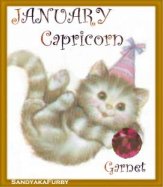|

Here are
birthday adoptables for you. I hope you like them. Right
click and "save as" to your own harddrive.
Please don't
forget to link them back to my website. There is a certificate
at the bottom of the page for you to use. Enjoy!

Garnet: January’s
Gemstone There are many ancient traditions and legends
about garnets. Some Hebrew writers include it as one of
the 12 gems in Aaron’s breastplate.
Christian tradition long considered the blood-red garnet
symbolic of Christ's
sacrifice. The Koran holds that it illuminates the Fourth Heaven
of the Moslems.
Garnet was said to give its wearer guidance in the night
allowing him to see
when others couldn’t. Legend claims that Noah hung a large
garnet in the ark for
illumination. According to the Egyptians, garnet is an antidote
for snakebite and
food poisoning.

Amethyst: February’s
Gemstone The ancient Greeks believed that whoever wore
an amethyst or drank from an amethyst chalice would not
fall victim to intoxication.
It is also said to have a sobering effect on those
over-excited by love’s passion. It
has symbolized peace, protection and tranquility. Some
say it will prevent baldness
and improve complexion, while protecting from treason and
deceit. Because royalty has always adored the color purple, amethysts
abound in the ornaments
of ancient Greeks and Egyptians, and in the British Crown
Jewels.

Aquamarine: March’s
Gemstone Derived from the Latin meaning “sea water,”
aquamarine was said to aid seafarers; thus it makes an
excellent gift for sailors or
those who travel frequently by sea. To dream of
aquamarine signifies the making
of new friends. To wear aquamarine brings love and
affection. They are thought to
give the wearers knowledge, foresight and assist in an
individual's inspiration. It is
a universal symbol of youth, fidelity, hope and health.

Diamond:
April’s Gemstone Even though the diamond is the hardest of all
gemstones known to man, it is the simplest in
composition: it is common carbon.
The ancient Greeks believed that diamonds were splinters
of stars fallen to earth. It
was even said by some that they were the tears of the Gods or
perhaps crystallized
lightning or hardened dew drops. The truth is, however, that the
exact origin of
diamonds is still something of a mystery, even to scientists and geologists. In
ancient times only kings wore diamonds as a symbol of strength,
courage and invincibility.
Over the centuries, the diamond acquired its unique status as
the ultimate gift
of love. It was said that Cupid’s arrows were tipped with
diamonds which have
a magic that nothing else can ever quite equal. The reason a
woman wears it on
the third finger of her left hand dates back to the early
Egyptian belief that
the vein of love ran directly from the heart to the top of the
third finger, left
hand.

Emerald:
May’s Gemstone The emerald is known as the Queen of Gems, and
the gem of queens.
The most prized is pure green or slightly bluish green. The
ancients held the emerald in great esteem, believing they
sharpened the wearer’s
eyesight and mind. The earliest engravers kept emeralds on their
work tables to gaze
upon from time to time to rest their tired eyes. Travelers
relied on emeralds
as protection against the hazards and perils of long journeys.
The green gem was
also said to give its owner the power to predict the future.

Cultured
Pearl: June’s Gemstone. Pearls come in a wide range of
colors from delicate rose white to black. The oriental
pearl is known as the gem of the moon. They have been recognized
as the emblem of modesty, chastity and purity. They have
also come to symbolize a
happy marriage.
-or-
Moonstone
is sometimes used as an alternative by those born in June since it
physically resembles some pearls.

Ruby:
July’s Gemstone The ruby is so named because of its rich red
color. Rubies
were thought to contain a glowing spark struck from the planet
Mars. Ancient lore
held that the ruby was capable of curing illness and reconciling
lovers quarrels.
Hindus referred to the ruby as “The Lord of the Gems,” and
believed its deep
red color came from an inextinguishable fire which was capable
of boiling water. It is said that a person should never make faces at a
ruby in a museum, and
never ignore it, for it was said to grow dull if slighted or not
worn or seen.

Peridot:
August’s Gemstone Peridot is sometimes referred to as an
“Evening Emerald”
because under artificial light the stone glows as a brilliant
green. The peridot symbolizes eloquence and persuasiveness.
Treasured peridots found their way into cathedrals during the
Crusades. Many legends state that peridot was considered
a powerful amulet against
all evil, as well as a remedy for sinus problems. It is said
that if the gem was set in gold, it had the power to protect its wearer from
terrors of the night, fears
and bad dreams. Peridots were especially favored by pirates.

Sapphire:
September’s Gemstone Sapphire, Some ancient writers claimed
the Ten Commandments were written on sapphire.
Ancient marriage partners had great faith in the stone,
believing it would not shine if
worn by the wicked or impure. They were reported to be an
excellent all-purpose medicine;
an antidote against poison and having the power to stop bleeding
and cure disorders
of the eye. Sapphires were considered to be so powerful they
continued to protect the original owner even after being
sold.

Opal:
October’s Gemstone There are more than a dozen varieties of
fiery and iridescent
opals. In fact, its tremendous color spectrum is the major
reason for the opal’s
mysterious attractiveness. The most popular have a white body
color with flashes
of many colors or “fire.” Opal
has symbolized hope, innocence and purity through the ages. In
the Middle Ages,
young fair-haired girls wore opals in their hair to protect its
lovely blond color.
Medieval writers believed the opal could render its wearer
invisible when the
need arose. The ancient Romans believed the opal was the king of
gems because it held within itself all the colors of the rainbow.

Topaz:
November’s Gemstone Topaz is a variety of quartz; colors range
from pale yellow to
yellowish-brown and red. The most popular fashion
colors are the vivid yellows and oranges. People once
carried it as a
protective talisman against the plague, bad skin and evil
thoughts. It was
also used as a charm against the bites of snakes and other
venomous reptiles.

Turquoise:
During the 16th century turquoise was used as currency by the
Southwest Indians.
They believed the gemstone could bring spoils to the warrior,
animals to
the hunter, and happiness and good fortune to all. Colors
in turquoise range from sky blue (most desirable color) to blue green
and apple green.
-or-
Blue
Topaz: December’s Gemstone Most people think of topaz as a
transparent golden
yellow gemstone. However, this gemstone also occurs in many
other colors. The name
topaz is derived from the Greek word meaning “to shine” and
also implies “fire.” The lore, magic and romance of topaz goes back
many thousands of years. It
holds the distinction of being the gemstone with the
widest range of curative powers.
Ancient Egyptians thought its golden glow symbolized “Ra,”
their sun god. The
Greeks felt it gave them strength. In addition, it supposedly
cooled tempers,
restored sanity, cured asthma, relieved insomnia and even warded
off sudden death.
Topaz is said to make its wearer invisible in times of
emergency.




Unless
otherwise noted, Copyrights (c) are retained by S & B Crafts
on all existing art, images and graphics located in this site.
All Rights Reserved.
This site originated on December 30,
1999 |